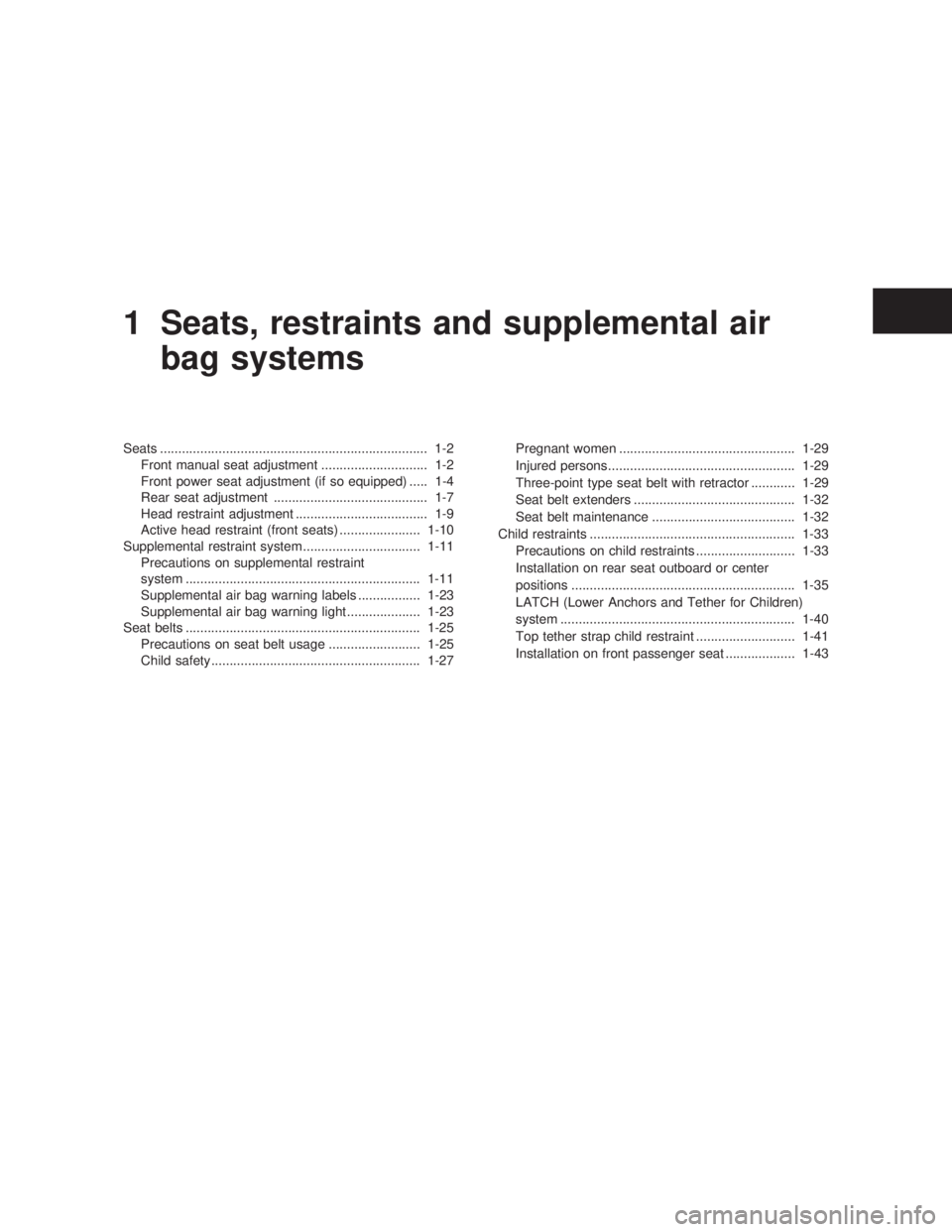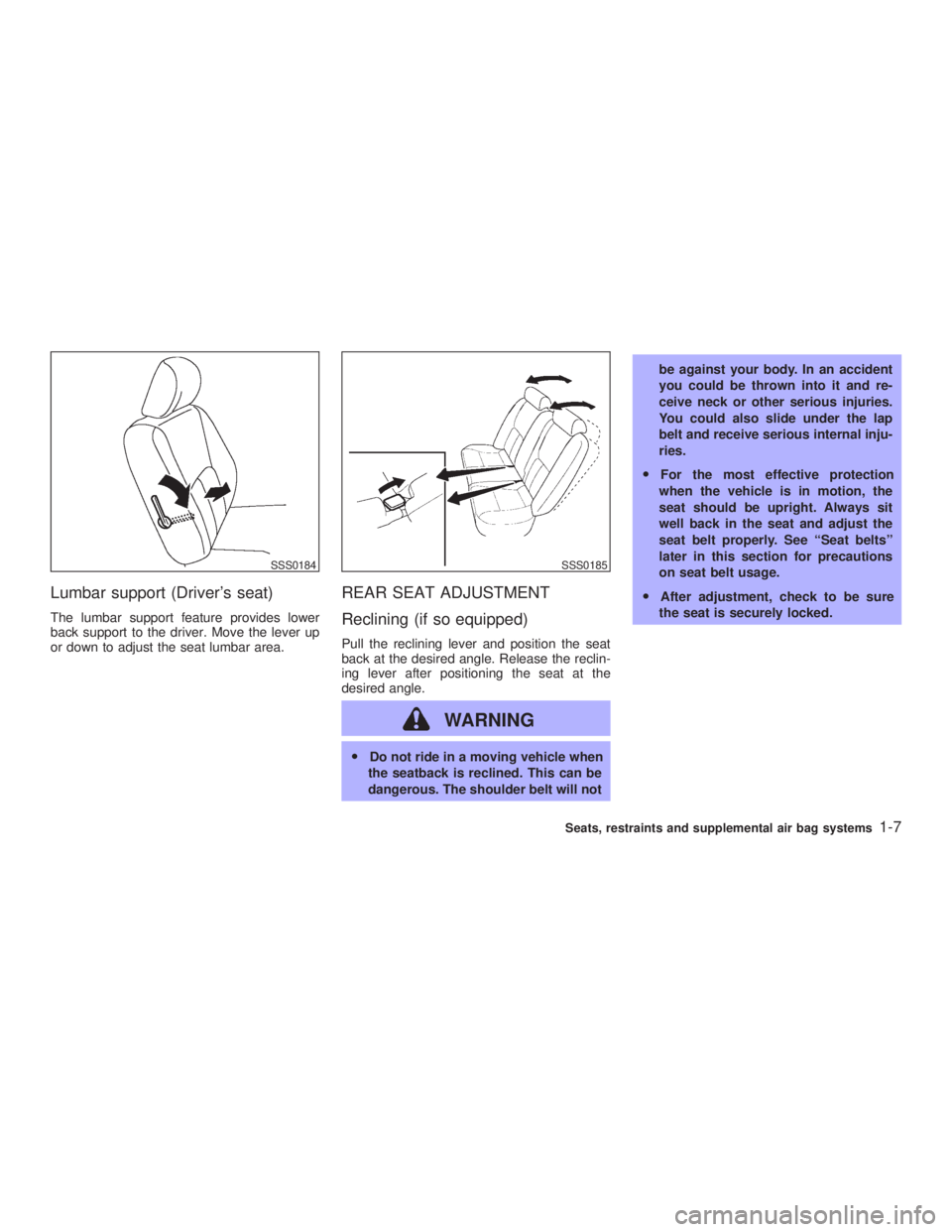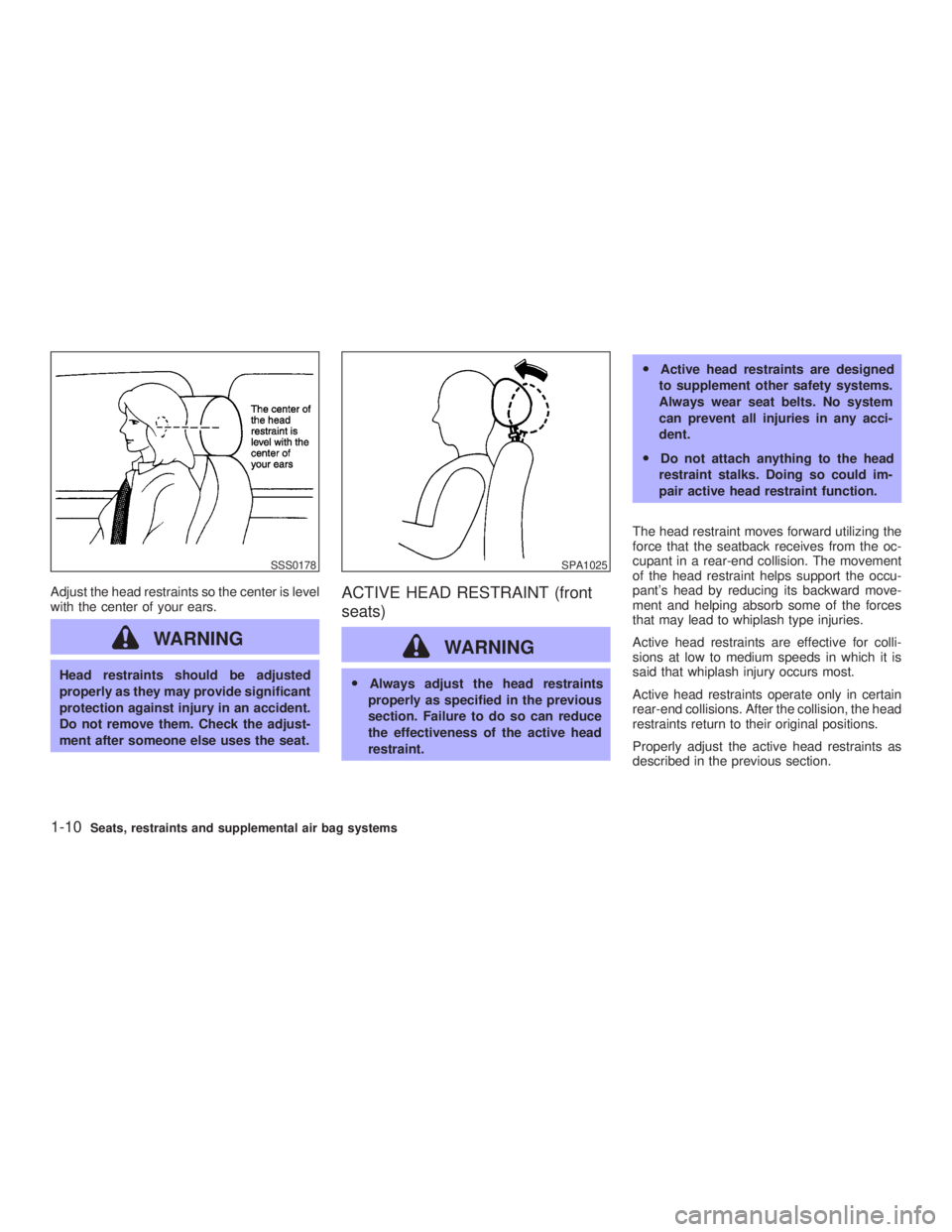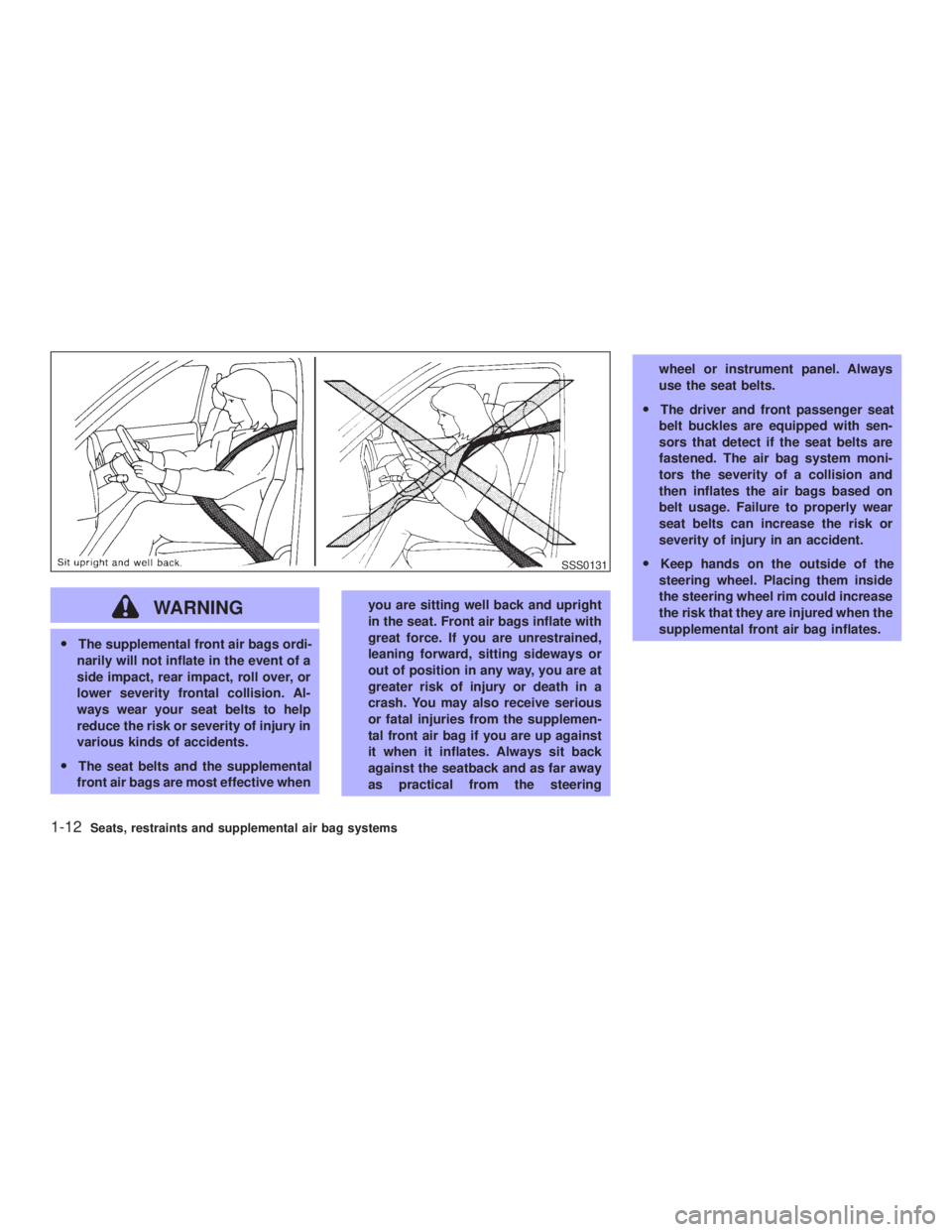2003 INFINITI G35 belt
[x] Cancel search: beltPage 1 of 256

Foreword Your INFINITI represents a new way of think-
ing about vehicle design. It integrates ad-
vanced engineering and superior craftsman-
ship with a simple, refined aesthetic sensitivity
associated with traditional Japanese culture.
The result is a different notion of luxury and
beauty. The car itself is important, but so is the
sense of harmony that the vehicle evokes in
its driver, and the sense of satisfaction you
feel with the INFINITI Ð from the way it looks
and drives to the high level of retailer service.
To ensure that you enjoy your INFINITI to the
fullest, we encourage you to read this Owner's
Manual immediately. It explains all of the
features, controls and performance character-
istics of your INFINITI; it also provides impor-
tant instructions and safety information.
A separate Warranty Information Booklet
can be found in your Owner's literature
portfolio. Always carry it with you when
you take your INFINITI to an authorized
retailer. The portfolio contents provide
complete information about all warranties
covering this vehicle, the periodic mainte-
nance required to keep the warranties in
effect as well as the INFINITI Roadside
Assistance program. Additionally, a separate Customer Care
and Lemon Law Information Booklet will
explain how to resolve any concerns you
may have with your vehicle, as well as
clarify your rights under your state's
lemon law.
INFINITI is dedicated to providing a satisfying
ownership experience for as long as you own
your car. Should you have any questions
regarding your INFINITI or your INFINITI re-
tailer, please contact our Consumer Affairs
department at 1-800-662-6200. In Hawaii
1-808-836-0888 (Oahu number). In Canada
1-800-361-4792. Thank you.
READ FIRST Ð THEN DRIVE
SAFELY Before driving your vehicle please read
your Owner's Manual carefully. This will
ensure familiarity with controls and main-
tenance requirements, assisting you in the
safe operation of your vehicle. WARNINGIMPORTANT SAFETY INFORMA-
TION REMINDERS FOR SAFETY! Follow these important driving rules to
help ensure a safe and comfortable trip
for you and your passengers!
O Never drive under the influence of al-
cohol or drugs.
O Always observe posted speed limits
and never drive too fast for condi-
tions.
O Always use your seat belts and appro-
priate child restraint systems. Preteen
children should be seated in the rear
seat.
O Always provide information about the
proper use of vehicle safety features
to all occupants of the vehicle.
O Always review this Owner's Manual
for important safety information.
Z 02.7.29/V35-D/V5.0
X
Page 7 of 256

1 Seats, restraints and supplemental air
bag systems Seats ......................................................................... 1-2
Front manual seat adjustment ............................. 1-2
Front power seat adjustment (if so equipped) ..... 1-4
Rear seat adjustment .......................................... 1-7
Head restraint adjustment .................................... 1-9
Active head restraint (front seats) ...................... 1-10
Supplemental restraint system ................................ 1-11
Precautions on supplemental restraint
system ................................................................ 1-11
Supplemental air bag warning labels ................. 1-23
Supplemental air bag warning light .................... 1-23
Seat belts ................................................................ 1-25
Precautions on seat belt usage ......................... 1-25
Child safety......................................................... 1-27 Pregnant women ................................................ 1-29
Injured persons................................................... 1-29
Three-point type seat belt with retractor ............ 1-29
Seat belt extenders ............................................ 1-32
Seat belt maintenance ....................................... 1-32
Child restraints ........................................................ 1-33
Precautions on child restraints ........................... 1-33
Installation on rear seat outboard or center
positions ............................................................. 1-35
LATCH (Lower Anchors and Tether for Children)
system ................................................................ 1-40
Top tether strap child restraint ........................... 1-41
Installation on front passenger seat ................... 1-43
Z 02.7.29/V35-D/V5.0
X
Page 8 of 256

WARNINGO Do not ride in a moving vehicle when
the seatback is reclined. This can be
dangerous. The shoulder belt will not
be against your body. In an accident
you could be thrown into it and re-
ceive neck or other serious injuries.
You could also slide under the lap
belt and receive serious internal
injuries. O For most effective protection when
the vehicle is in motion, the seat
should be upright. Always sit well
back in the seat and adjust the seat
belt properly. See ªPrecautions on
seat belt usageº later in this section. FRONT MANUAL SEAT
ADJUSTMENT
WARNING O Do not adjust the driver's seat while
driving so full attention may be given
to vehicle operation. The seat may
move suddenly and could cause loss
of control of the vehicle.
O After adjustment, gently rock in the
seat to make sure it is securely
locked. SSS0133
SEATS
1-2 Seats, restraints and supplemental air bag systems
Z 02.7.29/V35-D/V5.0
X
Page 12 of 256

O To return the seat to its original position,
raise the seatback and lock the seat. The
seat will return to its original position.
O The front passenger seat will stop at 7 in
(175 mm) from its frontmost position to
retain space for the rear passenger.
CAUTIONO When returning the seat to its original
position, confirm the seat and seat-
back are locked properly.
O Be careful not to pinch your hand or
foot or bump your head when operat-
ing the walk-in seat. The seatback will
fold down rapidly.
O Do not put any objects in front or rear
of the seat. They may be pinched and
damaged.
The automatic forwarding and reversing will
not work or stop under the following condi-
tions:
O When the vehicle speed is above 4 MPH (7
km/h).
O When the seat belt is fastened. O When the selector lever is not in the P
(Park) position (Automatic transmission
model's driver's seat) or the parking brake
is not applied (Manual transmission mod-
el's driver's seat)
O When the door is closed.
O When the slide adjusting switch is oper-
ated.
Seat lifter (Driver's seat) Pull the switch up or push it down to adjust the
angle and height of the seat cushion. SSS0183
1-6 Seats, restraints and supplemental air bag systems
Z 02.7.29/V35-D/V5.0
X
Page 13 of 256

Lumbar support (Driver's seat) The lumbar support feature provides lower
back support to the driver. Move the lever up
or down to adjust the seat lumbar area.
REAR SEAT ADJUSTMENT
Reclining (if so equipped) Pull the reclining lever and position the seat
back at the desired angle. Release the reclin-
ing lever after positioning the seat at the
desired angle.
WARNING O Do not ride in a moving vehicle when
the seatback is reclined. This can be
dangerous. The shoulder belt will not be against your body. In an accident
you could be thrown into it and re-
ceive neck or other serious injuries.
You could also slide under the lap
belt and receive serious internal inju-
ries.
O For the most effective protection
when the vehicle is in motion, the
seat should be upright. Always sit
well back in the seat and adjust the
seat belt properly. See ªSeat beltsº
later in this section for precautions
on seat belt usage.
O After adjustment, check to be sure
the seat is securely locked.SSS0184 SSS0185
Seats, restraints and supplemental air bag systems
1-7
Z 02.7.29/V35-D/V5.0
X
Page 16 of 256

Adjust the head restraints so the center is level
with the center of your ears.
WARNINGHead restraints should be adjusted
properly as they may provide significant
protection against injury in an accident.
Do not remove them. Check the adjust-
ment after someone else uses the seat. ACTIVE HEAD RESTRAINT (front
seats)
WARNING O Always adjust the head restraints
properly as specified in the previous
section. Failure to do so can reduce
the effectiveness of the active head
restraint. O Active head restraints are designed
to supplement other safety systems.
Always wear seat belts. No system
can prevent all injuries in any acci-
dent.
O Do not attach anything to the head
restraint stalks. Doing so could im-
pair active head restraint function.
The head restraint moves forward utilizing the
force that the seatback receives from the oc-
cupant in a rear-end collision. The movement
of the head restraint helps support the occu-
pant's head by reducing its backward move-
ment and helping absorb some of the forces
that may lead to whiplash type injuries.
Active head restraints are effective for colli-
sions at low to medium speeds in which it is
said that whiplash injury occurs most.
Active head restraints operate only in certain
rear-end collisions. After the collision, the head
restraints return to their original positions.
Properly adjust the active head restraints as
described in the previous section.SSS0178 SPA1025
1-10 Seats, restraints and supplemental air bag systems
Z 02.7.29/V35-D/V5.0
X
Page 17 of 256

PRECAUTIONS ON
SUPPLEMENTAL RESTRAINT
SYSTEM This Supplemental Restraint System (SRS)
section contains important information con-
cerning the driver and passenger front impact
supplemental air bags, front seat side-impact
supplemental air bags, curtain air bags and
front seat pre-tensioner seat belts.
Supplemental front impact air bag system:
This system can help cushion the impact force
to the face and chest of the driver and front
passenger in certain frontal collisions.
Supplemental side-impact air bag system:
This system can help cushion the impact force
to the chest area of the driver and front pas-
senger in certain side impact collisions. The
front seat side-impact supplemental air bags
are designed to inflate on the side where the
vehicle is impacted.
Supplemental curtain side-impact air bag
system: This system can help cushion the
impact force to the head of occupants in front
and rear outboard seating positions in certain
side impact collisions. The curtain side-impact
air bags are designed to inflate on the side
where the vehicle is impacted.
These supplemental restraint systems are de-
signed to supplement the crash protection provided by the driver and passenger seat
belts and are not a substitute for them. Seat
belts should always be correctly worn and the
occupant seated a suitable distance away
from the steering wheel, instrument panel and
door finishers. (See ªSeat beltsº later in this
section for instructions and precautions on
seat belt usage.)
After turning the ignition key to the ON
position, the supplemental air bag warning
light illuminates. The supplemental air bag
warning light will turn off after about 7
seconds if the systems are operational.SUPPLEMENTAL RESTRAINT
SYSTEM
Seats, restraints and supplemental air bag systems
1-11
Z 02.7.29/V35-D/V5.0
X
Page 18 of 256

WARNINGO The supplemental front air bags ordi-
narily will not inflate in the event of a
side impact, rear impact, roll over, or
lower severity frontal collision. Al-
ways wear your seat belts to help
reduce the risk or severity of injury in
various kinds of accidents.
O The seat belts and the supplemental
front air bags are most effective when you are sitting well back and upright
in the seat. Front air bags inflate with
great force. If you are unrestrained,
leaning forward, sitting sideways or
out of position in any way, you are at
greater risk of injury or death in a
crash. You may also receive serious
or fatal injuries from the supplemen-
tal front air bag if you are up against
it when it inflates. Always sit back
against the seatback and as far away
as practical from the steering wheel or instrument panel. Always
use the seat belts.
O The driver and front passenger seat
belt buckles are equipped with sen-
sors that detect if the seat belts are
fastened. The air bag system moni-
tors the severity of a collision and
then inflates the air bags based on
belt usage. Failure to properly wear
seat belts can increase the risk or
severity of injury in an accident.
O Keep hands on the outside of the
steering wheel. Placing them inside
the steering wheel rim could increase
the risk that they are injured when the
supplemental front air bag inflates. SSS0131
1-12 Seats, restraints and supplemental air bag systems
Z 02.7.29/V35-D/V5.0
X